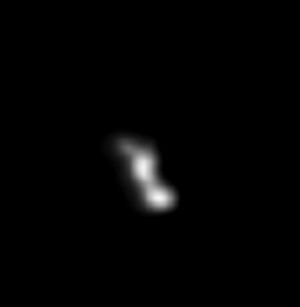(9969) Braille
|
Asteroid (9969) Braille |
|
|---|---|

|
|
| (9969) Braille captured by the Deep Space 1 spacecraft | |
| Properties of the orbit ( animation ) | |
| Orbit type | Main belt asteroid |
| Major semi-axis | 2.3410 AU |
| eccentricity | 0.4334 |
| Perihelion - aphelion | 1.3263 AU - 3.3557 AU |
| Inclination of the orbit plane | 28.9986 ° |
| Length of the ascending node | 242.0 ° |
| Argument of the periapsis | 356.1 ° |
| Sidereal period | 3.58 a |
| Physical Properties | |
| Medium diameter | 2.1 × 1.0 × 1.0 km |
| Albedo | 0.34 ± 0.03 |
| Absolute brightness | 15.9 mag |
| Spectral class | SMASSII: Q |
| history | |
| Explorer | E. Helin , K. J. Lawrence |
| Date of discovery | May 27, 1992 |
| Another name | 1992 KD |
| Source: Unless otherwise stated, the data comes from JPL Small-Body Database Browser . The affiliation to an asteroid family is automatically determined from the AstDyS-2 database . Please also note the note on asteroid items. | |
(9969) Braille is an asteroid of the main asteroid belt discovered on May 27, 1992 by Eleanor Helin and Kenneth J. Lawrence at the Palomar Observatory . It is about two kilometers long and one kilometer wide.
The asteroid was named on July 28, 1999 in honor of Louis Braille , the pioneer in the development of Braille .
Braille moves between around 1.3 astronomical units ( perihelion ) to 3.4 astronomical units ( aphelion ) in an elliptical orbit around the sun. The orbit is strongly inclined towards the ecliptic at 29 ° , the orbit eccentricity is 0.43.
On July 29, 1999, the Deep Space 1 spacecraft passed the very dark asteroid just 28 km away. Due to a technical error, however, the probe's automatic camera turned away from the asteroid so that no close-up pictures were taken. Only 15 minutes after the flyby - by this time the probe had already moved 13,500 km away - could recordings be made. They show an elongated, very irregular celestial body.
The composition of the spectrographic data from Deep Space 1 largely corresponds to that of Vesta . The asteroid is thus assigned to the V-type . Presumably it is a fragment of the large asteroid Vesta, which was cut off in the past as a result of a collision with another celestial body.
Web links
Individual evidence
- ↑ Oberst et al. (2001): A model for rotation and shape of Asteroid 9969 Braille from ground-based observations and images obtained during the Deep Space 1 (DS1) flyby ; Icarus 153, pp. 16-23
- ↑ Buratti et al. (2004): 9969 Braille: Deep Space 1 infrared spectroscopy, geometric albedo, and classification ; Icarus 167, pp. 129-135